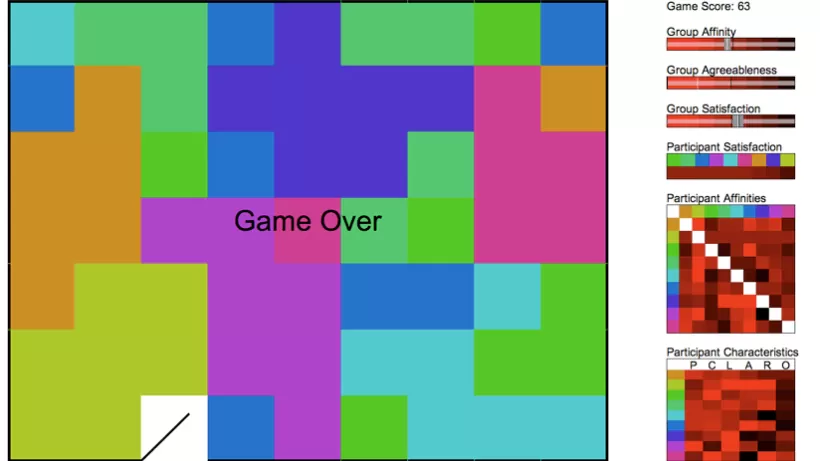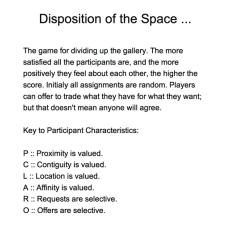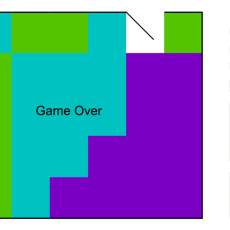Ever since the enclosing of the commons, there seems to have been a tendency for all grouped uses of space to reenact that tragedy on a petty scale. We have so well unlearned the communal use of space, that it is practically inconceivable; its laws and its rights are lost. Space is received by a group as a whole and in common, but its use is understood as individual and exclusive. Therefore, the space is divided. The extensive is exchanged for the discrete, the collaborative for the proximate, the expansive for the contained.
In a system that is governed equally by the unspoken assumptions of convention, and the only half-secret complexities of social relations, the disposition of the space is accomplished quickly, and with barely a sign of its reason, or a trace of its deliberations. If the question of fairness were raised, how would it be decided?
One solution might be to intensify the division of space; to fracture the area into more pieces than participants. A random distribution of the parceled resources tall participants evens out the inequality that results from the differential value of specific areas: everyone will have a little of everything. The fractions could then be used as is, or if the participants desired, they could exchange them with each other. At least then, they could negotiate the relative value of all the positions and track the material consequences of obligation and resentment.
The model for this experiment is the space of the gallery; the prized positions, for convenience and visibility, are those near the door and the walls.
The Rules
- Allow a random number of participants to play the game.
- Endow the participants with either the same or unique characteristics for how
- they value the proximity of their possessions
- they value the contiguity of their possessions
- concerned they are about the location of parcels (near doors and walls)
- sensitive they are to their affinity with other participants
- selective they are in their requests
- generous they are with their possessions
- affected their behavior is by their current level of satisfaction.
- Create a room of random dimensions with a door in one of its sides.
- Divide the space into equal parcels and distribute them at random to the players.
- Let the players take turns trading what they have for what they want in order to attempt to find a consensus for the disposition of the space.
- In a turn players offer one of their least valued possessions for one of the parcels they value most.
- The likelihood of the trade being accepted might depend on the affinity of the other player for the player making the request.
- The likelihood of the trade being accepted might depend on the other's current level of satisfaction.
- The likelihood of the trade being accepted might depend on the difference between the other players estimation of the value of the offer compared to the value of the request; if the difference is positive the trade is advantageous, if negative, disadvantageous.
- If a trade is accepted, the difference in value (as distinctly estimated by each side) is added to the affinity of each player for the other.
- If a trade is rejected, the difference in value (as distinctly estimated by each side) is subtracted from the affinity of each player for the other.
- After each turn the satisfaction of all players is calculated as the relation between their average valuation of what they possess compared to their average valuation of what they do not possess.
- Group satisfaction is calculated as the average of all the player's individual levels of satisfaction.
- Group agreeability is calculated as the historical tendency of all players to accept rather than reject offers to trade.
- Group affinity is calculated as the average level of affinity among all the players.



